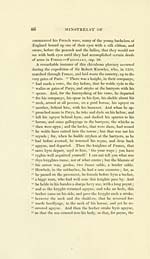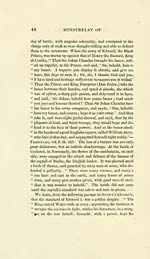Download files
Complete book:
Individual page:
Thumbnail gallery: Grid view | List view

THE SCOTTISH BORDEK. 47
" knyghte fell to the ertlie, and his horsse ran away, and cavne
" to the squyer, who abode for his mayster at the stretes ende.
" And so, the squyer toke the horsse, and had gret marveyle
" what was become of his mayster ; for he had well sene him
" ryde to the barryers, and stryke thereat with his glayve, and
" retourne agayne. Thanneherodealytellforthe, thyderwarde,
" and anone he saw where his master layn upon the erthe,
" bytwene foure men, layenge on him strokes, as they wolde
'' have stryken on a stethey {anvil) ; and than the squyer was
" so affreyed, that he durst go no farther : for he sawe well he
" could nat help his mayster. Therefore he retourned as fast
" as he myght : so there the sayd knyghte was slayne. And
" the knyghtes, that were at the gate, caused hym to be buried
" in holy groimd." — Fkoissart, ch. 281.
A similar instance of a military jeopardy occurs in the same
author, ch. 36i. It happened before the gates of Troyes.
" There was an Englyshe squyre, borne in the bishopryke of
■" Lincolne, an expert man of armes ; I can nat say whyder he
" could se or nat ; but he spurred his horse, his speare in his
" hande, and his targe about his necke ; his horse came rushyng
" downe the waye, and lept clene over the barres of the bary-
" ers, and so galoped to the gate, where, as the Duke of Bur-
" goyne and the other lords of France were, who reputed that
" dede for a great enterprise. The squyer thoughte to have re-
" turned, but he could nat ; for his horse was stryken with
" speares, and beaten downe, and the squyr slain ; wherewith
" the Duke of Burgoyne was right sore displeased."
Wilt thou lend rue our King's standard,
To bear a little way ?— P. 29. v. 4.
In all ages, and in almost aU countries, the miUtary stand-
ards have been objects of respect to the soldiery, whose duty
it is to range beneath them, and, if necessary, to die in their
defence. In the ages of chivalry, these ensigns were distin-
guished by their shape, and by the various names of baimers,
pennons, pcnoncellcs, ike, according to the number of men
who were to light under them. They were displayed, on the
" knyghte fell to the ertlie, and his horsse ran away, and cavne
" to the squyer, who abode for his mayster at the stretes ende.
" And so, the squyer toke the horsse, and had gret marveyle
" what was become of his mayster ; for he had well sene him
" ryde to the barryers, and stryke thereat with his glayve, and
" retourne agayne. Thanneherodealytellforthe, thyderwarde,
" and anone he saw where his master layn upon the erthe,
" bytwene foure men, layenge on him strokes, as they wolde
'' have stryken on a stethey {anvil) ; and than the squyer was
" so affreyed, that he durst go no farther : for he sawe well he
" could nat help his mayster. Therefore he retourned as fast
" as he myght : so there the sayd knyghte was slayne. And
" the knyghtes, that were at the gate, caused hym to be buried
" in holy groimd." — Fkoissart, ch. 281.
A similar instance of a military jeopardy occurs in the same
author, ch. 36i. It happened before the gates of Troyes.
" There was an Englyshe squyre, borne in the bishopryke of
■" Lincolne, an expert man of armes ; I can nat say whyder he
" could se or nat ; but he spurred his horse, his speare in his
" hande, and his targe about his necke ; his horse came rushyng
" downe the waye, and lept clene over the barres of the bary-
" ers, and so galoped to the gate, where, as the Duke of Bur-
" goyne and the other lords of France were, who reputed that
" dede for a great enterprise. The squyer thoughte to have re-
" turned, but he could nat ; for his horse was stryken with
" speares, and beaten downe, and the squyr slain ; wherewith
" the Duke of Burgoyne was right sore displeased."
Wilt thou lend rue our King's standard,
To bear a little way ?— P. 29. v. 4.
In all ages, and in almost aU countries, the miUtary stand-
ards have been objects of respect to the soldiery, whose duty
it is to range beneath them, and, if necessary, to die in their
defence. In the ages of chivalry, these ensigns were distin-
guished by their shape, and by the various names of baimers,
pennons, pcnoncellcs, ike, according to the number of men
who were to light under them. They were displayed, on the
Set display mode to: Large image | Transcription
Images and transcriptions on this page, including medium image downloads, may be used under the Creative Commons Attribution 4.0 International Licence unless otherwise stated. ![]()
| Early Gaelic Book Collections > J. F. Campbell Collection > Minstrelsy of the Scottish border > Volume 1 > (249) |
|---|
| Permanent URL | https://digital.nls.uk/80611314 |
|---|
| Description | Vol. I . |
|---|---|
| Shelfmark | Cam.2.d.17 |
| Additional NLS resources: | |
| Attribution and copyright: |
|
| Description | Volumes from a collection of 610 books rich in Highland folklore, Ossianic literature and other Celtic subjects. Many of the books annotated by John Francis Campbell of Islay, who assembled the collection. |
|---|
| Description | Selected items from five 'Special and Named Printed Collections'. Includes books in Gaelic and other Celtic languages, works about the Gaels, their languages, literature, culture and history. |
|---|

